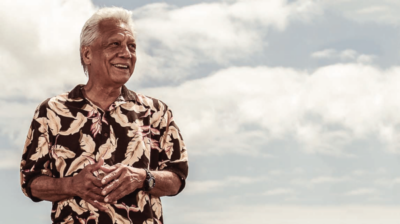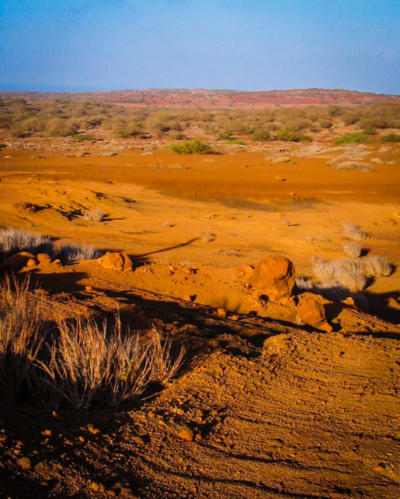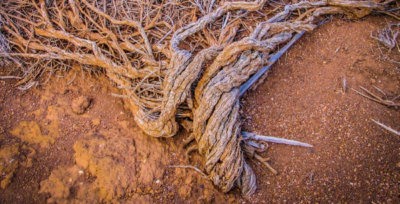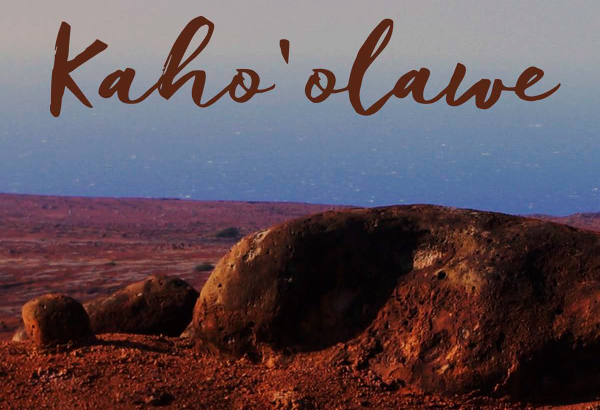AN ISLAND IN PERIL FIGHTS FOR A GLIMMER OF HOPE For three Native Hawaiian leaders with intimate ties to the island, Kaho‘olawe is a powerful sy

Photo: Noa Kekuewa Lincoln
AN ISLAND IN PERIL FIGHTS FOR A GLIMMER OF HOPE
For three Native Hawaiian leaders with intimate ties to the island, Kaho‘olawe is a powerful symbol of loss and devastation as well as regrowth and healing. Dr.
Noa Emmett Aluli was a medical student when he founded the Protect Kaho‘olawe ‘Ohana (PKO) and led the movement to stop military test bombing on Kaho‘olawe in the ’70s. Michael Naho‘opi‘i was a Navy officer who oversaw the island’s military cleanup before becoming executive director of the Kaho‘olawe Island Reserve Commission (KIRC). Derek Kekaulike Mar was a student in one of the early PKO cleanups who has since gone on to lead restoration efforts on Kaho‘olawe as an environmental specialist and Native Hawaiian consultant. They each seem to live in two different worlds, with one foot in modern Western society and the other in traditional Hawaiian culture. On the 40th anniversary of the first occupation of Kaho‘olawe, Emmett Aluli, Mike Naho‘opi‘i and Derek Kekaulike Mar look back at the violent history of the island, the ongoing challenges to restore it and the promise this former sanctuary holds for the future.
Prior to Western contact, Kaho‘olawe was considered an important training ground for the ancient art of way finding, or celestial navigation. The island was named after Kanaloa, the Hawaiian god of the ocean, and is still considered sacred by Native Hawaiians, navigators and fishermen. The island also served as a pu‘uhonua, or sanctuary, where people went to seek refuge and be healed.
When Captain George Vancouver arrived with the first Westerners at the end of the 18th century, he left 200 goats on the island as a gift to Kahekili, the leader of Maui. The goats multiplied, and ranches were established with sheep and cattle.
Together, the voracious ungulates devoured most of the greenery on the island. Without native grasses and plants, the topsoil began to erode off the land, leaving it arid and barren. Due to its devastated ecosystem, the island was abandoned and later used as a penal colony.

“It was an ugly scene, yet there was beauty in the land.” —Noa Emmett Aluli
Photo: Dave Miyamoto
After the attack on Pearl Harbor in 1941, the U.S. Navy took over Kaho‘olawe and used it for target practice for the war in the Pacific theater. The military continued bombing the island for almost 50 years, during which time Kaho‘olawe became the most heavily bombed island in the world. But with the rise of the Hawaiian Renaissance, a group associated with the Aboriginal Lands Of Hawaiian Ancestry (ALOHA) movement decided to stop the bombing and take back the island in 1976.
Noa Emmett Aluli:
Doctor and healer Dr. Noa Emmett Aluli is a soft-spoken physician who heads up Moloka‘i General Hospital, but don’t let his white hair and laidback manner fool you. He once stood up to the most powerful military in the world to stop the bombing of Kaho‘olawe, and he still leads the movement to restore the island and return it to the Hawaiian people.
Aluli was one of nine individuals who left Maui and crossed the ‘Alaläkeiki Channel on January 4, 1976, headed for Kaho‘olawe. The group called themselves the Protect Kaho‘olawe ‘Ohana (PKO).
Critics claimed it was naïve and even foolish to challenge the U.S. Navy, but their actions would change the history of Hawai‘i and the movement for indigenous rights. From that day forward, they were known as the Kaho‘olawe 9.
While the others were detained and escorted off the island that day, Aluli and fellow Native Hawaiian activist Walter Ritte hiked into the interior to survey the damage from five decades of bombing. Two days later, the two men were handcuffed, arrested and barred from ever returning.
“It was an ugly scene, yet there was beauty in the land,” Aluli says in the documentary series Standing on Sacred Ground.
A young surgical resident at the time, Aluli was risking his life and jeopardizing his medical career, but he knew he had a higher calling to heal his people and the land of Kaho‘olawe. Aluli went on to occupy the island many more times with the PKO. Led by Hawaiian singer and activist George Helm, the group filed a class action lawsuit against the military later that year. Helm once said that Hawaiian culture will only exist if “the life of the land is perpetuated in righteousness,” and he and Kimo Mitchell of the PKO became martyrs for the cause when they disappeared at sea during a rescue mission to the island in 1977.
It was an uphill battle, but the grassroots group miraculously prevailed. In 1980, the PKO settled its lawsuit with the Navy and was granted access to the island for four days each month. The Navy agreed to pay $440 million in damages to protect cultural sites, clear surface ordnance and begin soil conservation programs. “What we were able to do was magic,” Aluli says.
It was an amazing accomplishment, but the PKO still had a long way to go before reaching its goal of taking back the island.
Under the terms of the agreement, the Navy was allowed to continue bombing the central part of the island, and cleaning up after 50 years of bombing and military exercises seemed an impossible task.
Michael Naho‘opi‘i: Naval officer and lauhala weaver
Born and raised on O‘ahu, Mike Naho‘opi‘i went to the Naval Academy after graduating from Kamehameha Schools and was then deployed by the Navy. He had always hoped to return to Hawai‘i,
and he got his wish when he was stationed at Pearl Harbor in 1993. But he soon learned that his home state was undergoing a dramatic political transformation. On the 100th anniversary of the overthrow of the Hawaiian Kingdom, tensions with the military were running high.
Naho‘opi‘i was working as a Navy lieutenant on a nuclear sub when he heard that the admiral in command of the U.S.
Pacific Fleet at Pearl Harbor wanted to see him. The admiral was looking for a junior officer to oversee the cleanup of Kaho‘olawe, which had become a political quagmire for the Navy. As a Native
Hawaiian commander with a background in engineering, Naho‘opi‘i seemed to have the right qualifications. Upon learning that Naho‘opi‘i had been among the first groups of students allowed to do research and cleanups on Kaho‘olawe after the PKO settled its lawsuit with the Navy, the admiral knew he had found the right man for the job.
Naho‘opi‘i was briefed by the former commander to expect serious animosity from the Native Hawaiian group. But when they met with the PKO volunteers, Naho‘opi‘i recognized two cousins and an old friend. Even though there was still tension over the continued bombing of the island, the young officer helped defuse the animosity between the military and the Native Hawaiian groups.
During that first year, Naho‘opi‘i witnessed a series of social, economic and political developments that would transform Kaho‘olawe and the movement for Hawaiian sovereignty. President George H. W. Bush halted bombing on Kaho‘olawe in what Naho‘opi‘i saw as a political gesture to help fellow Republican Pat Saiki get into office. Senator Daniel Inouye seized the opportunity to sponsor legislation that transferred ownership of the island from the military to the state of Hawai‘i, leading to the creation of the Kaho‘olawe Island Reserve Commission (KIRC) in 1993. That same year, the newly inaugurated President Bill Clinton issued an apology for the 1893 overthrow of the Hawaiian Kingdom. “All the stars were in alignment,” Naho‘opi‘i says. “It’s an interesting study in politics.”
After heading up the cleanup for the military, Naho‘opi‘i worked for a few years as a civilian contractor on Kaho‘olawe before becoming the head of KIRC. As executive director of KIRC, Naho‘opi‘i and his 16 staff members are in charge of managing the island’s infrastructure, protecting its cultural and historical sites and working with PKO volunteers to continue rehabilitation and restoration of its damaged ecosystem.
“We are looking at everything from physically restoring the land to spiritually restoring the land to spiritually restoring the people who are doing the restoration,” Naho‘opi‘i says. The physical labor is back breaking, especially in such a hot, dry place, but the work is therapeutic. By teaching people how to heal, he hopes they can go back and heal their own communities.
Does he feel conflicted about having been a part of the military that was responsible for so much destruction of the island? “My role has always been to try to find the middle ground and get both parties to come to an agreement,” Naho‘opi‘i says. “Kaho‘olawe succeeded because of compromise.”
During his many trips to the island, Naho‘opi‘i began studying the art of ulana (weaving) with young Hawaiians who
came over to help clean the island. The process of weaving lauhala mats and hats calmed his nerves and connected him to his culture. “My kumu has always said, ‘You’re weaving relationships to create the future,’” Naho‘opi‘i says. “So we’re trying to weave all these aspects of Kaho‘olawe together.”

Photo: Noa Kekuewa Lincoln
To Naho‘opi‘i, the restoration of the island is not only about planting seeds and growing trees but creating future leaders.
“Kaho‘olawe has always been the training ground for the Hawaiian people,” he says.
“Even for the younger generation, they’ve had a history of going there as students.” Derek Kekaulike Mar: Environmental consultant and Hawaiian cultural advisor Derek Mar first came to Kaho‘olawe as a student in Davianna McGregor’s Hawaiian studies class at the University of Hawai‘i at Mänoa in 1996. McGregor gave her students the choice of writing a long essay, working in the taro patch on campus or going to Kaho‘olawe for a weekend. “That was a no-brainer for me,” Mar laughs, recalling that first visit. “I fell in love with the place.”
During one of his trips to the island, Mar met the woman who would become his wife. Planting seeds and working the land brought them closer together. Their relationship grew around their shared passion for restoring Kaho‘olawe’s scarred but still beautiful landscape. Over the last two decades, Mar has worked as a regular volunteer for the PKO and as an environmental consultant and Native Hawaiian advisor for companies helping with the rehabilitation of the island.
As an environmentalist, Mar sees Kaho‘olawe as a symbol of mankind’s destructive ways. But as a Native Hawaiian, Mar believes the island also reflects mankind’s best qualities. He’s amazed by the amount of effort, energy and time that community groups and individuals have given to revive and restore the island.
Mar has invested so much sweat equity into Kaho‘olawe that he considers it his home. He lives on O‘ahu and works in a high-rise downtown, but he looks forward to his frequent trips to the uninhabited island. “It’s not just a physical home, but a spiritual home for me,” Mar says. “It’s a place I go back to recharge my batteries, to remind me of what’s important in life.” Mar estimates that he has put almost a million seeds and plants in the ground, most of which have struggled due to the lack of rainwater and fertile soil. How do you maintain and nurture those seeds in the face of such overwhelming odds? “That’s my ongoing mission,” he states. “I think it’s a lifelong adventure. It’s a lifelong kuleana with Kaho‘olawe.”
Mar admits that it will take a long time for the island to be fully restored, but he is inspired by visions of how sacred and beautiful the island once was and will be again. “I’ll be happy if one day I can sit with my grandkids in the shade of a tree that I planted,” Mar says. “Then I’ll know that my work on Kaho‘olawe is done.” In 2015, the Association for Tropical Biology and Conservation issued the Honolulu Declaration in Support of Cultural and Biological Restoration of Kaho‘olawe Island Reserve. The document recommends that the military continue to fund efforts to finish the job of clearing unexploded ordnance from the island, stating that “the full biocultural restoration of Kaho‘olawe is important not only for Hawai‘i and Native Hawaiians, but as a model for how restoration could be achieved following demilitarization anywhere in the world.”
Unfortunately, the Navy’s $440 million settlement to clear the ordnance and fund the work of the Kaho‘olawe Island Reserve Commission came to an end last year.
The state legislature passed a bill to fund KIRC for two more years, but there is no long-term plan in place. Still, despite Kaho‘olawe’s dismal past and uncertain future, Mike Naho‘opi‘i believes it is never too late to change course and restore the environment. “If we can heal Kaho‘olawe,” he says, “we can heal anyplace.”

Photo: Noa Kekuewa Lincoln
